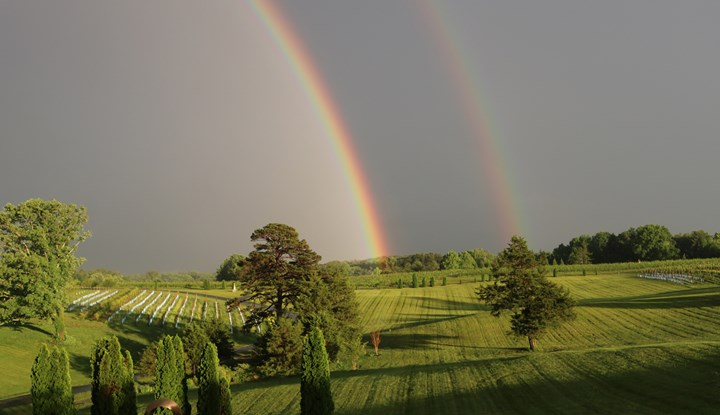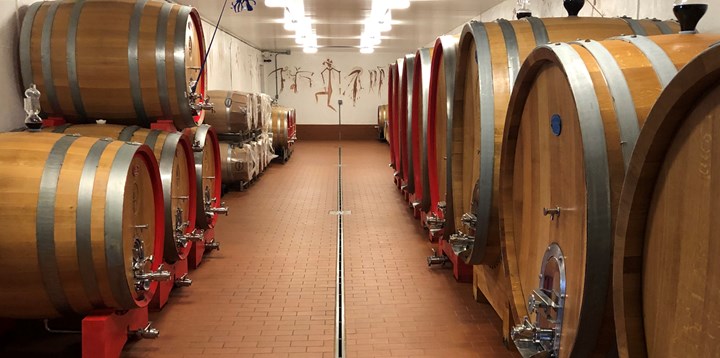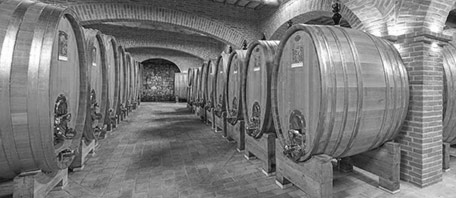
Which site would you like to visit?
By clicking the retail or wholesale site button and/or using rarewineco.com you are choosing to accept our use of cookies to provide you the best possible web experience.

“The wines are poised, tense, very silky, very elegant: they are a credit to their Mentor Soldera.”
- Margaret Rand, The World of Fine Wine
Thomas Jefferson knew the great wines of Europe better than anyone else in America. And he believed in his soul that wines of such quality could be made in his home state of Virginia.
Jefferson spent nearly a half century trying and failing, because of Virginia’s difficult growing environment—and of course because of Phylloxera. Eventually Virginians figured out how to conquer Phylloxera, which allowed them to grow European varieties successfully. And they even learned about how to cope with the state’s famous humidity.
By the 1980s, it had become apparent that, among all the Eastern States, Virginia had a unique potential to make world-class red wines. It had also become clear that the Cabernet Franc grape held the most promise.
The prospect of Virginia wines rivaling the great Cabernet Francs of Chinon and Saumur-Champigny seemed almost within reach. Some even dared imagine wines that one day could rival Cheval Blanc or Lafleur, arguably Bordeaux’s two greatest showcases for Cabernet Franc.
Nearly a half century has now passed, and Virginia is still looking for its Game Changer—the estate that would finally demonstrate for the world that Cabernet Franc had found its providential home in America.
We believe that estate has now been found in the foothills of the Blue Ridge Mountains. Its name is Ramiiisol.
The property was founded in 2013 by Robert Hefner III and his wife, MeiLi, who turned to wine after each retiring from long careers outside of the wine industry.
Their inspiration grew out of their close friendship with the late Gianfranco Soldera, whom they met in 2005. Robert was (in the words of the New York Times) “one of the world’s premier natural gas wildcatters” from Oklahoma. But he was also a respected geologist. And the way Soldera thought about terroir resonated with him and MeiLi, inspiring them to not only make their own wine but to apply Robert’s gifts in a quest to make great wine.
The Hefners looked at vineyards in France, Italy and California, but none excited them. Then, in 2013, by accident, they found 57 hectares of land in the foothills of the Blue Ridge Mountains, near Charlottesville, Virginia. There were 10 acres of vineyards planted in 2000. Of the ten acres, six were of Cabernet Franc.
According to Margaret Rand, writing in World of Fine Wine, Robert noticed “that the bedrock was folded and fractured,” allowing for superior root penetration. And after buying the property, Robert and MeiLi brought in, at Soldera’s suggestion, the world-renowned expert on wine terroirs, Pedro Parra, to dig countless “pits.”
Parra discovered that, while there are numerous micro-terroirs on the property, the soil is generally a mixture of granite and gneiss, which is a metamorphic rock made from the same mineral components as granite that is most famously found in Côte Rôtie.
The soil is a deep red/orange color with hard granite at the base, which allows for deep roots to set. It is a minerally rich environment for Cabernet Franc and brings wonderful transparency to the wines it produces.
“Wines that make me dream.”
- Pedro Parra on Ramiiisol
Like Jefferson, the Hefners saw potential for greatness in their land. And, they were determined to work their vineyards in a way that captured that potential.
From the beginning, they eschewed any artificial products in their vineyards. This simple idea may seem obvious in a dry climate like Southern France, but it is incredibly challenging with Virginia’s famously humid summers. Without resort to modern fungicides, mildew could take off in a matter of days.
The Hefners were willing to risk losing their crop in service to making the wine of their dreams. But they also had to do something about the chemicals that were being used by the previous owners. They went “cold turkey” on chemicals, and the viticultural has been, since the first vintage in 2014, organic.
Crucial to their success has been their winemaker, Robbie Corpora. The son of a prominent Virginia winemaking family, Robbie had deep experience with Virginia’s climate. A gifted viticulturist, he was determined to help build a healthy ecosystem in the vineyards – one that would support the vines’ own immune systems. His team invests in intensive foliage removal and pruning to maximize airflow and ensure that his healthier vines have the very best opportunities.

Ask any of the world’s great wine pioneers, and they will tell you that their first vintage was one of trial and error. Which parcels produce the finest fruit? What vinification is appropriate? Should aging be in small or larger barrels, new or old? And how long should the wine be left in wood?
Luckily, from the very first vintage, two parcels on the property were identified as the estate’s greatest, now named Buck Mountain (1.14 hectares) and Free Union Block (1.29 hectares). Exposure is quite similar, with the two blocks oriented northeast by southwest. However, Buck Mountain is planted over a rolling terrain slightly sloped north.
The differences in soil are far more dramatic. Free Union has a higher clay content, in a way that’s similar to how Cheval Blanc has heavier clay soils than other Saint Emillion estates, resulting in exceptional depth and power. Buck Mountain instead has a thinner layer of red clay in the second horizon, and sandy subsoils.
Now the question was, how to vinify the wines.
The Hefners were inspired by the wines of their friend Soldera, which are made in traditional botti made of Slavonian oak. A little-known American tradition of aging Bordeaux varietals in large-format wood also exists. The first and arguably most famous example is the Cabernet wines of Mayacamas, which have been raised in large redwood vats for decades. More recently, Promontory has shown the astonishing qualities Cabernet can reveal when matured in large botti.
So, drawing on Antonini’s relationships, they convinced two of Italy’s greatest barrel makers—Garbellotto and Gamba—to supply the kind of thick-staved botti you’d find in the best Barolo and Montalcino cellars. But they also bought a few conventional barriques.
Free Union’s fruit fit squarely in the 15hl Gamba, but Buck Mountain had many different subplots. So, initially, Buck Mountain, along with other sites, was put into neutral barrique. After a year, the best barrels of Buck Mountain were placed into the 22.5hl Garbellotto.
In their quest to take the fruit from Free Union and Buck Mountain to the next level, Robbie and Alberto created a 50/50 blend of the two makers’ botti to become Ramiiisol’s first great Cabernet Franc Riserva. Ultimately the wine spent four years in botte followed by one year in bottle prior to release. A mere 300 cases were made.
“We are starting to achieve something that is very unique in the U.S. I haven't seen this in other places.”
- Pedro Parra
The debut 2014 Riserva has already become somewhat mythic. Margaret Rand gave it a 96-point rating in Decanter. It was also the only American Cabernet Franc on the Decanter list of ten “Top-Rated” Cabernet Francs she assembled to demonstrate the grape’s growing geographic diversity.
Jancis Robinson was also impressed by the 2014 Riserva, choosing it to represent North America at her Smithsonian launch of the 8th edition of The World Atlas of Wine. At the launch tasting, she proclaimed the wine “remarkable.”
Thanks to the brilliance of the 2014 Riserva, when the great 2017 vintage came around, the Hefners and their team knew which plots deserved to go directly into their Garbellotto and Gamba botti to eventually become the year’s Riserva.
And, once again, the wine enjoyed a long slumber in barrel. The 2017 spent a full 45 months in botte—the sort of regime you might have seen in one of the great Brunello or Barolo cellars of the past, bringing extraordinary complexity and integration to the wine.
Given Virginia’s capricious weather, a Riserva is not guaranteed every vintage. And, lately, it seems that Mother Nature has been particularly ungenerous in even-numbered years.
In 2018, less than 200 cases of the estate’s normal Cabernet Franc bottling could be made. And in 2020, that figure dropped to just over 100 cases. The 2022 vintage looks little better. There will be no prized Riserva from these vintages.
On the other hand, we can look forward to a stunning series of Riservas from recent odd-numbered vintages. The 2019 Riserva, which will be released in 2025, is superb, as will be the two separate bottlings of Buck Mountain and Free Union to be released as Riservas from 2021. The 2023, which still has at least two more years in barrel ahead of it, also looks enormously promising.
If you were to ask Pedro Parra and Alberto Antonini what excites them most about Ramiiisol, it’s how its complex, and even challenging, environment has opened the door to making wines unlike anything yet seen in America.
While the most famous viticultural areas of the American West Coast are dry environments of intense sun, in Eastern Virginia you have to deal with rain and clouds which, in the words of Antonini, “filter the light.” It is an environment far closer to Burgundy or Barolo than to Napa Valley.
Antonini goes on to say that in most of his other projects in the new world, “I've never been able to age wines for such a long time because they start to decline a bit during the oak aging. Here they are growing. The evolution of the wine is very much what you see in very prestigious wine region like … Montalcino or Barolo. By keeping the wine in oak for more time, it creates even a more complex aromatic profile.”
Pedro Parra adds: “After ten years, we are starting to achieve something that is very unique in the U.S.”
For 250 years, winemakers have pursued Jefferson’s dream of making wine in Virginia that captures the magic of Europe’s best. And for most of that time, it wasn’t clear it was even possible.
But with the release of Ramiiisol’s first two extraordinary, yet embryonic, vintages of Cabernet Franc Riserva, that dream has clearly become a reality.
New discoveries, rare bottles of extraordinary provenance, limited time offers delivered to your inbox weekly. Be the first to know.
Please Wait
Adding to Cart.
...Loading...


By clicking the retail or wholesale site button and/or using rarewineco.com you are choosing to accept our use of cookies to provide you the best possible web experience.

